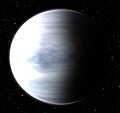Kepler-1708b (previously known as KIC 7906827.01) is a Jupiter-sized exoplanet orbiting the Sun-like star Kepler-1708, located in the constellation of...
14 KB (1,222 words) - 13:42, 20 August 2024
exhibits higher systematics that may explain their differing conclusions. Kepler-1708b PDS 70 2MASS J11193254–1137466 AB Subsatellite V1400 Centauri Chou, Felicia;...
7 KB (600 words) - 04:26, 29 July 2024
Kepler-22 is a Sun-like star in the northern constellation of Cygnus, the swan, that is orbited by 1 planet found to be unequivocally within the star's...
10 KB (659 words) - 21:55, 24 August 2024
Kepler-452 is a G-type main-sequence star located about 1,810 light-years away from Earth in the Cygnus constellation. Although similar in temperature...
13 KB (1,189 words) - 08:01, 9 May 2024
orbiting it. Kepler-289 hosts four planets, three confirmed (Kepler-289b, Kepler-289c, Kepler-289d) and one unconfirmed candidate (Kepler-289e). The discovery...
6 KB (376 words) - 09:35, 9 May 2024
December 2023 — The exomoon candidate around Kepler-1625b was again challenged, along with the Kepler-1708b candidate. This study argues that the statistical...
27 KB (2,211 words) - 16:12, 29 July 2024
Kepler-385 (also designated KOI-2433) is an F-type main-sequence star located about 4,900 light-years (1,500 parsecs) away from Earth in the constellation...
7 KB (464 words) - 22:21, 22 March 2024
from the Kepler space telescope and confirmed in 2015. None of the planets orbit within the habitable zone. Kepler-445b, c, and d orbit Kepler-445 every...
6 KB (348 words) - 02:01, 27 September 2023
Kepler-70, also known as KIC 5807616 and KOI-55, is a star about 3,600 light-years (1,100 parsecs) away in the constellation Cygnus, with an apparent visual...
12 KB (1,094 words) - 18:13, 23 August 2024
Kepler-443b is an exoplanet about 2,540 light-years from Earth. It has an 89.9 percent chance of being in the star's habitable zone, yet only a 4.9 percent...
4 KB (273 words) - 20:32, 20 January 2024




